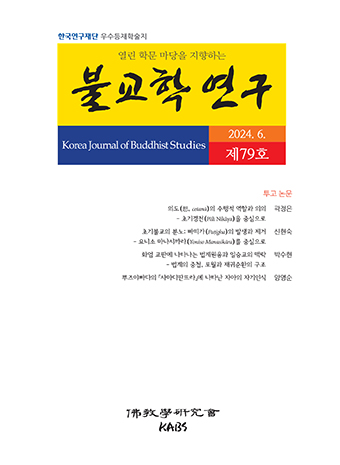Abstract
References
Sorry, not available.
Click the PDF button.
Information
This treatise is written to mark the 1,400th anniversary ofWoncheuk 圓測 birth and stimulate a new approach to studies onWoncheuk's Buddhist thoughts 敎學. To do this, I divided previousstudies on Woncheuk's Buddhist thoughts into two broad areasand reviewed them critically. The first are the subjects whichscholars have so far mainly concentrated on, the significance ofwhich must be reconsidered critically. The other are the subjectswhich I believe are very important in understanding the essenceof Woncheuk's Buddhist thoughts, although they have onlysuperficially been studied three or four times. As to the former, I critically reviewed the trend of academicstudies attempting to clarify the character of Woncheuk'sBuddhist thoughts by examining Woncheuk's attitude towardsthe acceptance of Paramārtha's 眞諦 theories, and where he stoodon the theory that sentient beings are naturally divided into fivegotra-s 五姓各別說. I conclude that over nearly 100 years of study,from Hadani 羽溪 (1916) to Kitzekawa 橘川 (1999), there hasbeen little advancement beyond the level of either reaffirmingor merely modifying the expression of the established theory setforward by Hadani. This theory states that Woncheuk emphasizedParamārtha's theories, pioneered the idea that all sentient beingscan become a buddha 一切皆成說, and was a compromiser betweenthe new and the old. As to the latter, I reviewed studies on the essence of teaching敎體 and yoga-śamatha-vipaśyanā 瑜伽止觀, and emphasized theimportance they play in Woncheuk's Buddhist thoughts althoughthey have never been the subject of much attention from scholars. Wŏnch'ŭk' is a scriptural commentator who devoted his life tohelp others understand the Buddhist truth, so it was importantfor him to explain the essence of the sacred teachings 聖敎 as aspoken language. Further, as he is a scholar who upholds the greattraditions of yogācāra buddhism, we need to consider carefully themeaning of the idea yoga 瑜伽. Yoga in a broad sense can be thegrand principle of the commentaries on scriptures or his viewpointon all Buddhist theories. Yoga in a narrow sense can also be akind of academic methodology and ultimately the best means tosupreme enlightenment and emancipation. Through these discussions, I conclude as follows: theaforementioned Woncheuk's stance on Paramārtha's theories and the five gotra-s have perhaps been attracting the attention ofscholars who regarded Woncheuk's Buddhist thoughts as merelyanother faction of the Fa-shang school 法相宗. To reveal the uniquecharacteristics of Woncheuk's Buddhist thoughts and his greatscholarly achievement, there needs to be a much greater focus onthe subjects which Woncheuk himself regarded as those of greatimportance.
이 글은 원측탄생 1400주년을 맞이하여 원측교학을 새롭게 철학적으로 조명하기 위한 목적에서 쓰인 것이다. 이를 위해, 나는 20세기 초부터 근 100년간 행해진 원측교학의 연구 동향을 크게 두 부류로 구분하여 비판적으로 검토하였다. 첫째는 지금까지 집중적으로 연구되어왔지만 그 의의를 재고해 보아야 할 문제들이다. 둘째는 기존의 연구에서 피상적으로 다루어지고 말았지만 원측교학의 본질을 이해하는데 중요하다고 여겨지는 문제들이다. 전자와 관련해서는, 진제의 학설을 수용하는 원측의 태도나 ‘오성각별(五性各別)’에 대한 그의 입장을 확인함으로써 원측교학의 특징을밝히려 했던 연구 경향에 대해 비판적으로 검토하였다. 여기서는 하다니(羽溪, 1916)에서부터 기츠카와(橘川, 1999)에 이르는 근 1세기에걸친 기존의 연구들이 별다른 진전을 이루지 못한 채, 다만 하다니에의해 확립된 정설, 즉 ‘진제(眞諦) 계통의 학설을 중시하고 일체개성(一切皆成)을 창도했으며 신역과 구역의 절충형’이라고 하는 주장을재차 확인하거나 조금 수정하는 차원에 머물고 있음을 지적하였다. 후자와 관련해서는, 기존의 학자들에 의해 크게 주목받지 못했지만‘교체론(敎體論)’과 ‘유가지관(瑜伽止觀)’이 원측교학에서 갖는 중요한 의의를 부각시켰다. 여기서는 원측이 불교적 진리에 대한 이해를증진시키는 데 헌신했던 위대한 경전주석가였다는 점에서 그에게 무엇보다 ‘성스런 교설[聖敎]’ 자체의 본질, 즉 ‘교체’에 대한 해명이 교학연구의 일차적 과제가 될 있음을 강조하였다. 또 그가 유가행파(瑜伽行派)의 계보를 잇는 학자라는 점에서 맨 먼저 ‘유가’의 이념이 원측교학에서 어떤 의미를 갖는지 살펴볼 필요가 있다. 광의의 ‘유가’는 경문해석의 대원칙이나 불교 교학 전체에 대한 관점으로 작용할 수 있고,또 협의의 ‘유가’(지관)는 일종의 학문적 방법론이자 궁극적으로는 보리·해탈에 이르는 최상의 방편이기도 하다. 이상의 논의를 통해, 진제와의 관계나 오성각별의 문제는 원측을 법상종의 이파(異派)로 간주하는 사람들의 관심사에 불과할 수 있다는것, 그리고 원측교학의 사상적 특징과 위대함을 드러내기 위해서는 원측 자신이 진정으로 중요하게 여겼을 주제들을 중심으로 연구해야 함을 강조하였다
Click the PDF button.
- Publisher :Korean Association of Buddhist Studies
- Publisher(Ko) :불교학연구회
- Journal Title :Korea Journal of Buddhist Studies
- Journal Title(Ko) :불교학연구
- Volume : 38
- No :0
- Pages :295 ~ 328


 Korea Journal of Buddhist Studies
Korea Journal of Buddhist Studies






